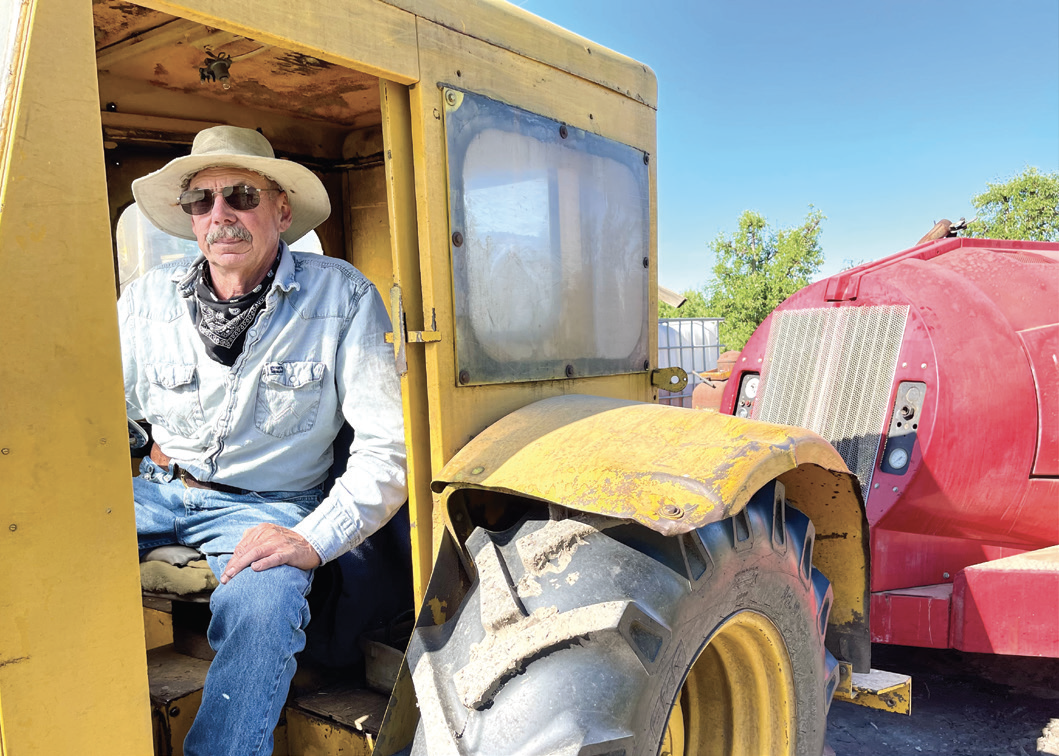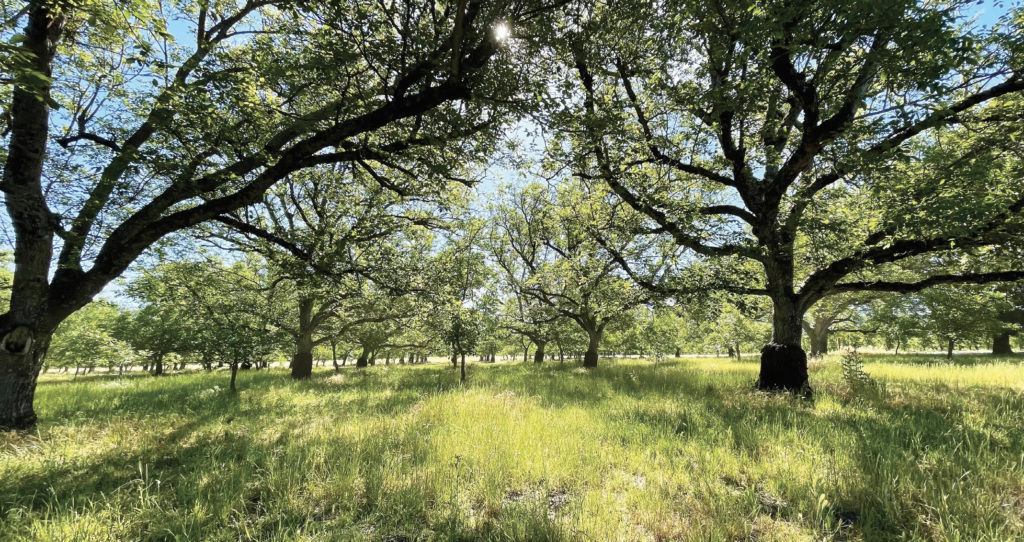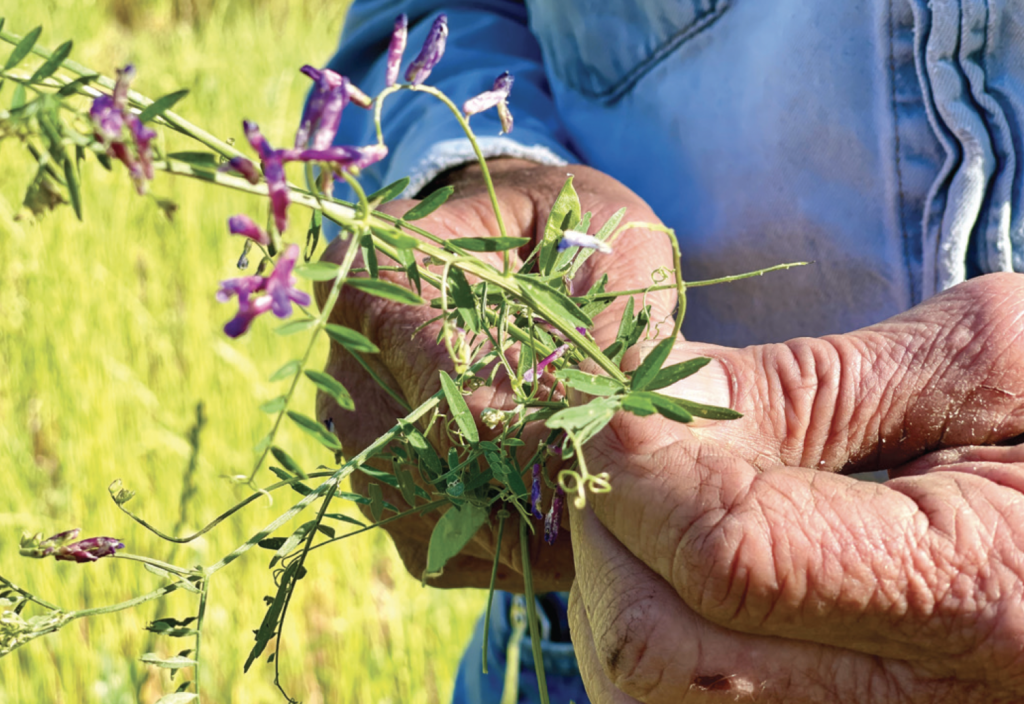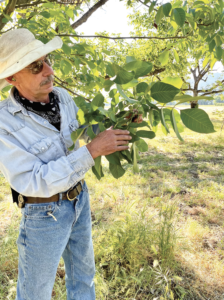
Aug 19, 2021
How Extension research led to Kelsey Creek Orchards going organic
David Mostin never intended to be a walnut grower. His early experiences in walnuts – a small five acres that his grandfather had – weren’t his favorite, as he would often have to pick walnuts in the fall after school and in the mud. Even then, the walnuts were a far second to the pears that both his grandfather and father grew during a time when California had a booming pear market.
Mostin didn’t get his own start until after studying engineering and anthropology at the University of California, Berkeley, and in 1980, he purchased his first orchard – a pear orchard that had been abandoned for a year. By the time he upgraded in 1986 to 50 new acres of pears, along came 15 acres of walnuts with it.
The pears were planted in the early 1900s and, with a few interplantings, are still producing today. The walnuts were planted in 1944-1945 in two different varieties, which Mostin farmed conventionally until 2001, when he began his operation’s adventure into organic. The walnuts have been organic since 2004, which is when he began the transition on the first block of pears.
But, Mostin’s journey was kickstarted by what seems like a serendipitous merge of a number of factors that moved him into organic.
“When (University of California Cooperative Extension) was working on BlightBan A506, I had an orchard in one of the test plots,” Mostin said of his start in working alongside Extension. “And when they were starting hormone confusion for codling moth, I was in the middle of an areawide program.”
 Researchers were discovering a resistance in codling moth to organophosphates, as well as uncovering more about the negative effects on the healths of pollinators and other beneficial insects.
Researchers were discovering a resistance in codling moth to organophosphates, as well as uncovering more about the negative effects on the healths of pollinators and other beneficial insects.
“I got a better understanding of how organophosphates would kill the predators, and then the mites would go crazy, and then we’d spray for the mites, and it would just be this vicious circle,” Mostin said.
The mating disruption alternative was registered for organic, and that’s when Mostin decided he would take five of his acres and give it a shot. He started with the walnuts instead of the pears because of the low codling moth pressure in walnuts at the time and in his county in general.
There was also the price differential among organic and conventional crops, especially in pears, which had already undergone multiple industry contractions in the state. And, as luck would have it, once Mostin started the switch, the price differential got worse, not better. For the first time in his decades of production, he had to sell off some acreage in order to recapitalize.
“Economics were a driving force,” he said. “If you looked around and saw your neighbors at the time, who had been building out these orchards your whole life, and you’re doing the same things they’re doing, it’s kind of silly to just stand there and not make changes and watch an identical operation go out of business, and you not at least attempt to do something different to not follow the same path.”

A lot of the neighboring pear and walnut acreage went to winegrapes, and Mostin had no interest in becoming a winegrape grower. The changes in the market, combined with organic practices in and of themselves, were tough.
But, “I figured it was an opportunity to try to stay in business,” Mostin said.
It’s no secret that a part of the economic loss in crops is due to the cost of labor. It’s why Mostin has fabricated his own picking and pruning platforms for use in his pears in order to mechanize and reduce costs. The same is true for the walnuts. With Lake County being one of the later districts, harvest is often done in the rain and without machines since they’re too difficult to navigate in the mud. He occasionally would hire machine operators to harvest, but when his son Glenn found a used machine harvester in the Central Valley, Mostin ran the numbers and went and picked it up that same day.
“The ROI was kind of shocking for me. It was a no-brainer,” he said.
Labor costs were not as big of a production cost when he first entered the field 40 years ago as they are now, which is why Mostin is looking forward to mechanization.
The power of a cover

Starting his farming career in the 1980s meant Mostin farmed in an era that preached monoculture and the preconception that cover crops stole a significant amount of good water and nutrients from the crop.
“That meant disk the cover crop out and weed band spray under the trees, so you just had dirt and trees,” he recalled.
The first issue Mostin had in his pre-organic walnut orchard was soil compaction. In a neighboring orchard, he had seen the grower run the irrigation and have standing water in the middle of summer, which was unheard of. The grower would disk the cover in the spring, keep it clear until harvest, and maybe add a new cover after harvest if there wasn’t too much rain.
A couple years before Mostin bought this orchard, the previous grower had deep ripped it. It made no improvements to the standing water issue, which Mostin then inherited with his purchase.
“There was such little organic material that the dirt formed clods the size of a bowling ball that I couldn’t break with a 70-horsepower wheel tractor,” said Mostin. “It was unbelievable.”
This immediately led him to his local University of California Cooperative Extension (UCCE) office, where he grabbed a book about cover crops in orchards and vineyards. Following the recommendations of Montezuma oats and purple vetch, Mostin got a beautiful stand, and when he did testing, he discovered his field was setting 100lbs. of nitrogen when the walnuts only needed 50lbs.

“That was a win. I saw a difference in the soil texture and the standing water in the first year – there was a reduction,” Mostin said. “In the second year, it was really obvious.”
Mostin stuck to his same processes and irrigation sets. In the third year, the compaction and standing water problem was gone.
To remain cost effective in those earlier days, he would let it reseed itself every year until the third year, when the stand would be less than half and scraggly enough to warrant new seed. These days he’s taking a more aggressive approach and replants every year. When his orchard became part of another University of California research experiment, this time involving cover crops in pears over three years, he was excited about the changes being made and wanted to be sure the walnut acreage wasn’t left out.
2020 was the first year Mostin didn’t cultivate for the calendar year. He used a new flail mower instead of a rotary mower and was able to machine harvest off of essentially a mowed floor.
“That was pretty exciting,” he said. “We always fought the early rains and picking in the mud, but I can come in on a machine the day after a rain and keep picking, whereas I could never have done that before.”
Of course, the fall and winter of 2020 didn’t see much rain at all in California, so Mostin’s excitement for trying out his new machinery was cut short.
“But, someday it might rain again, maybe,” he laughed.
Mostin admits that he took the soil benefits for granted, especially when production agriculture is geared so much towards enhancing the productive capabilities of an organism. It’s an artificial environment, he said, and it’s really easy just to put on the processed fertilizer.
“It just goes right in,” said Mostin. “You skip the middleman. It’s like putting an IV into a patient instead of having them eat a regular meal.”
Mostin now plants a 100% cover crop stand every year in the walnuts, knowing that it would help the crop more than if they were unaided by boosting soil activity and improving nitrogen.
Being in the path of the UCCE experiments is partly why Mostin credits Extension with helping him become the organic operation he is today, though it isn’t without its challenges.
“It’s more difficult. The organics thing is just unbelievable when compared to conventional. Especially when you don’t know what the hell you’re doing,” he joked.
Those days of organic naivete are long behind him, but was it all worth it?
“Yes, absolutely,” he said. “Hands down.”






